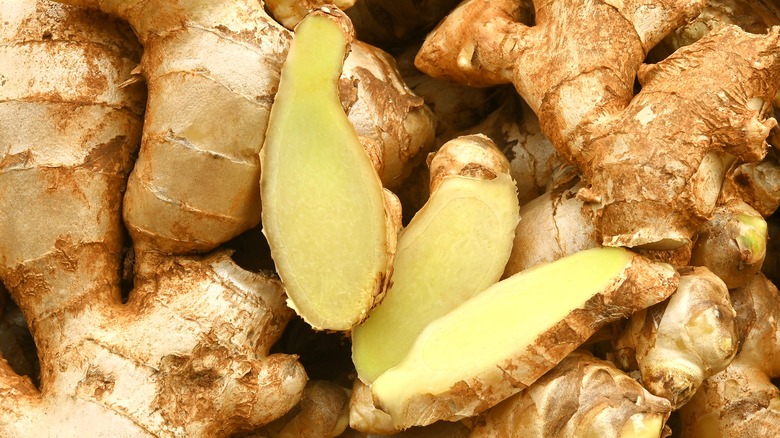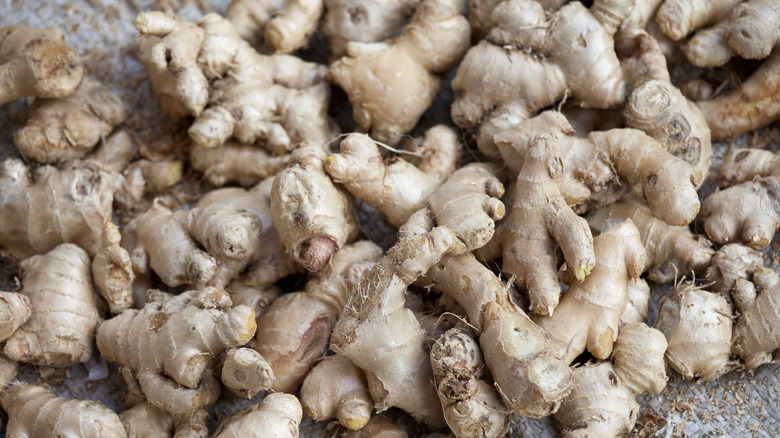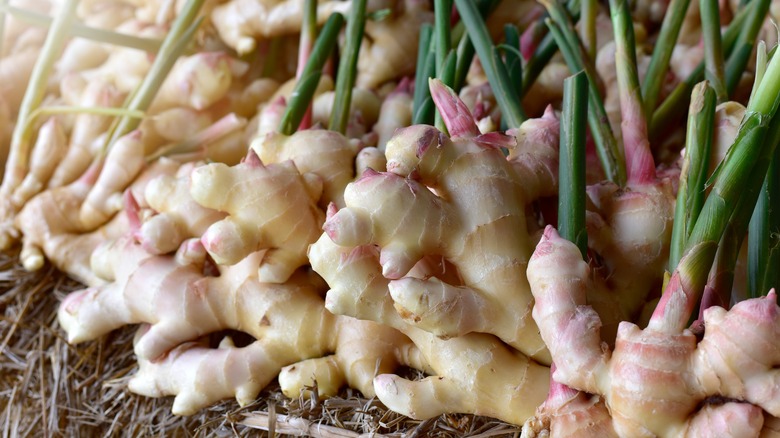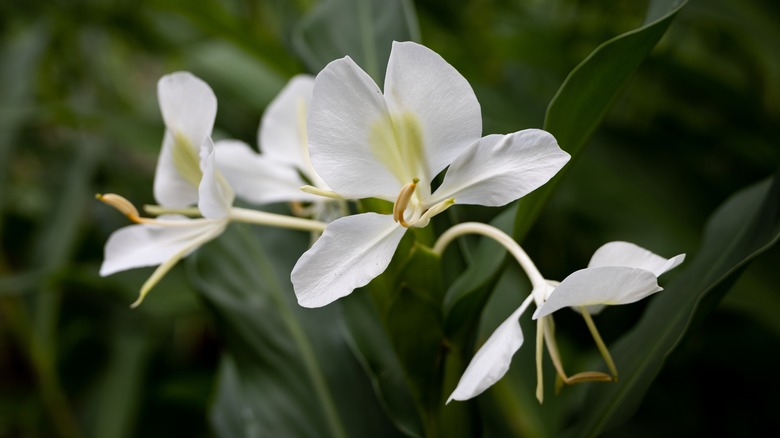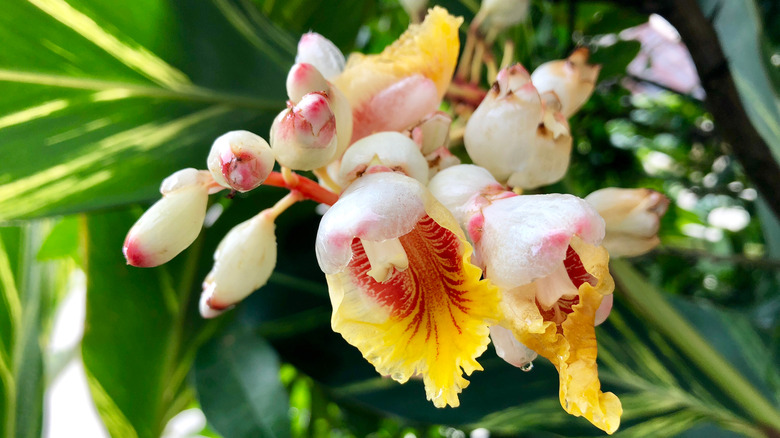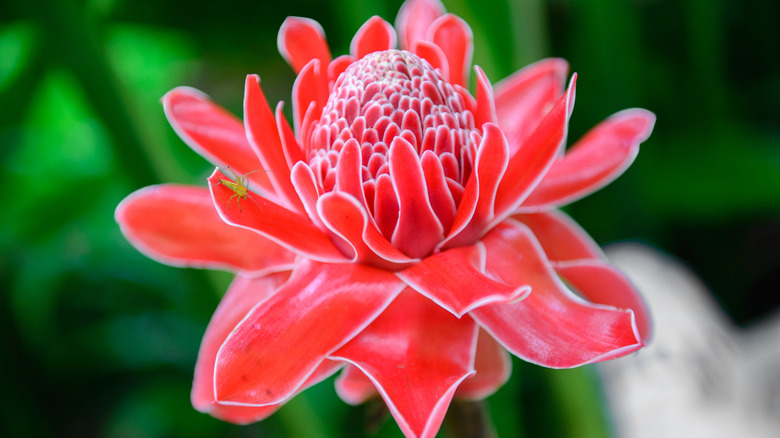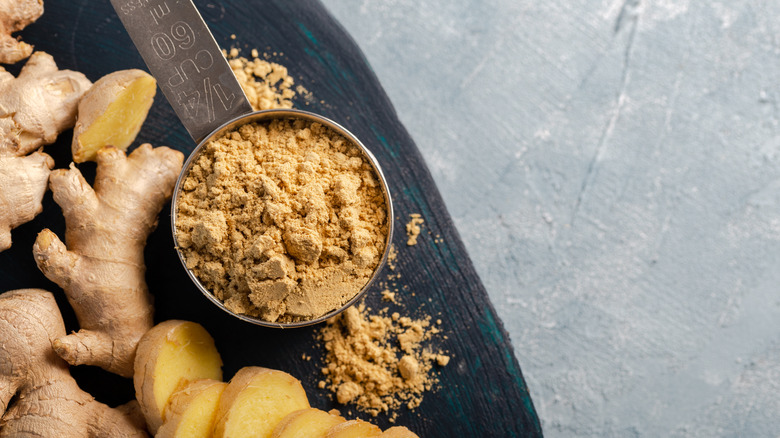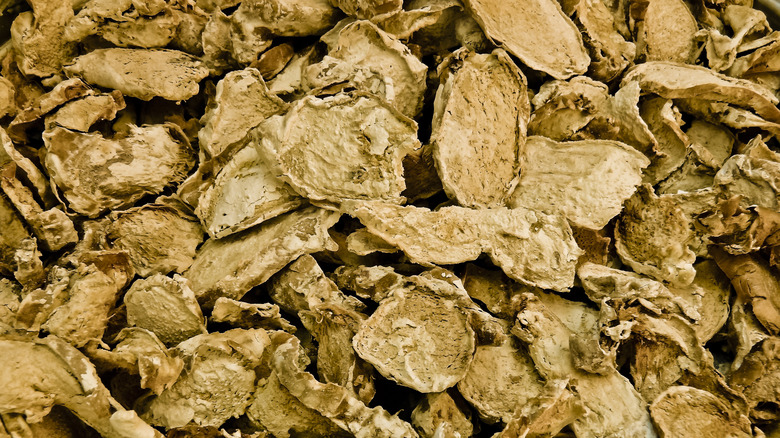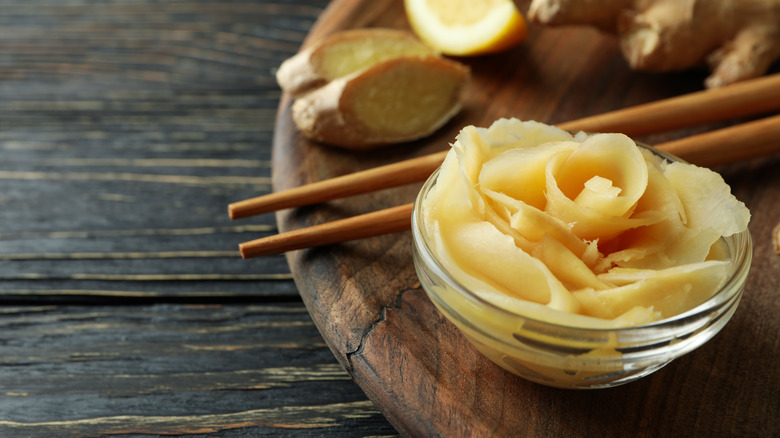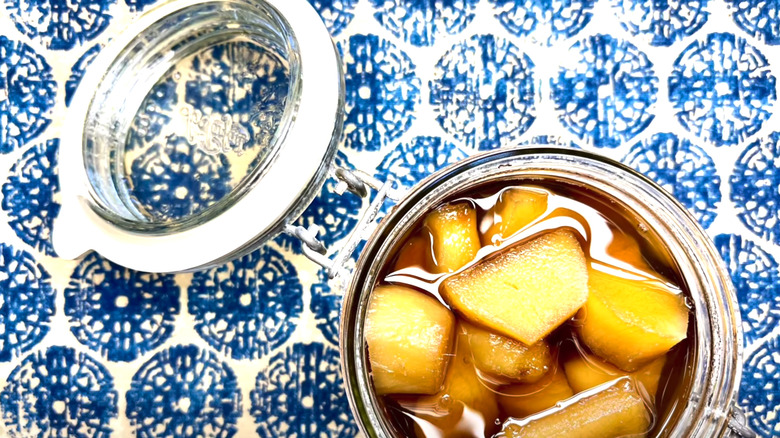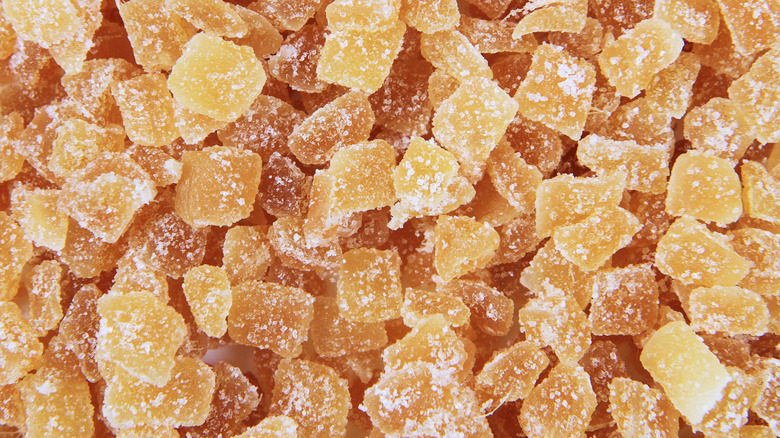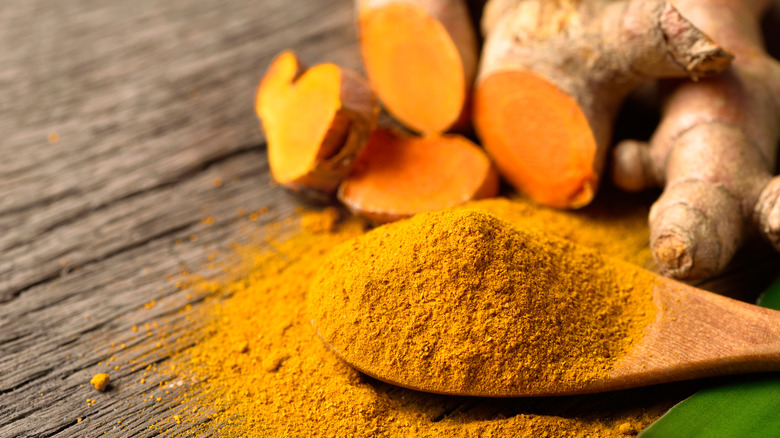12 Varieties Of Culinary Ginger, Explained
As part of the aromatic family, culinary ginger not only comes in many varieties, it carries a long list of health benefits. Enjoyed worldwide, it shapeshifts, carrying a fragrant zinger that ranges from spicy to sweet. Although common culinary ginger is often mistaken for a root, it's actually a rhizome that originates from the underground "root-like" stem of a tropical flowering plant called Zingiber officinale. The ancient plant ginger originates from is over 4000 years old, yet is believed to have been a treatment for ailments in Asia since before recorded history.
In fact, ginger's beneficial qualities are quite astounding. Its high level of antioxidants is only surpassed by pomegranates, blueberries, raspberries, and blackberries. Additionally, ginger's health benefits include being a powerful deterrent to inflammation, cancer growth, and nausea. Next time you have an upset stomach, drink some ginger tea or grab a ginger shot from your local market. It's easily one of the healthiest and most effective remedies.
When combined with food, ginger adds complexity to the flavor profile. For savory dishes, it works as a peppery pairing. Baked goods like gingersnaps and gingerbread bring out its sweet side. There's no doubt that every kitchen should have ginger in its inventory. If you're looking to add some spice to your life, this list of ginger varieties and their culinary uses will help turn the heat up.
Select fresh and mature ginger
Mature ginger is most commonly used in cooking. Some standout characteristics are its tough, dry-looking skin, fibrous flesh, and spicy kick. The pungency found in fresh ginger comes from a nonvolatile compound named gingerol, which is concentrated in the skin. Gingerol contains properties similar to capsaicin, the compound that makes chilies spicy, as well as piperine from black pepper.
When picking out fresh ginger, the skin should be firm yet smooth. Your fingernail will easily remove the skin with a soft scrape. If you find that the skin is too thick, it's a sign the ginger isn't as fresh, and probably not the best option for cooking. Freshness can also be determined by snapping off a piece of the root. If the piece easily snaps free from the chunk, you'll know it's good to go.
In the kitchen, mature ginger works great for a diverse selection of dishes. A fresh ginger and salmon recipe is perfect for a quick midweek dinner. You can have twice the cultural experience with a Portuguese chicken curry recipe that comes from Macanese cuisine. And if meat isn't on the playlist, queue up these spicy barbecued tofu kebabs.
Eat baby ginger for added nutrition
Ginger starts producing health benefits early in its growth process. Young ginger contains twice the amount of micronutrients and nearly three times the antioxidants as mature ginger. Due to its lower shelf life, unless you live in Southeast Asia, baby ginger is rarely available at local grocery stores. That's gradually changing as more people become aware of its life-enriching benefits and culinary capabilities.
Baby ginger can be identified by the shades of pink in its skin, its non-fibrous consistency, and its juicy flesh. It's typically picked after four to eight months of growth. Also distinct in flavor, young ginger has a subtle spiciness that's joined by a hint of floral on the back palate. The spiciness soon disappears, unlike mature ginger's lasting impression. A fun fact to know about making sushi is that baby ginger is fresher tasting and more malleable, which is why young ginger is used for pickling.
Cooking with the mild tang of baby ginger is enjoyed best in salads, noodles, desserts, and drinks. Furthermore, its soft skin doesn't require peeling to be consumed, so you can add slices or grate gingery shavings right on top.
Add butterfly ginger to a savory recipe
Beyond the typical culinary ginger's numerous benefits and uses, there are a number of types from its family tree that are great to cook with. Butterfly ginger, otherwise known as white ginger, is one particularly fragrant variety that originates from Southeast Asia, but is now found in tropical climates around the world. While mostly considered ornamental ginger that's used in gardening, its tubers and flowers are actually edible as well. Unlike common culinary ginger, butterfly tubers can be consumed, but they're not as flavorful.
As one of many ingredients almost exclusively found in Asia's rich culinary history, butterfly ginger is not often used for cooking in other parts of the world. According to Flowers of India, in the Northeast Indian state of Manipur, butterfly ginger rhizomes are used in a traditional dish called eromba, and it's prepared using dried and fermented fish, as well as locally available vegetables. Surprisingly, more flavor is said to be found in butterfly ginger flowers and flower buds, which are potently fragrant, and when steamed, can be added as a garnish to salads. If you're in need of a soothing sip, you can also add enhance tea with their floral zest.
Gain medicinal properties from shell ginger
Shell ginger is named after its pearlescent pink seashell-shaped flowers. According to a 2018 study, published in Nutrients, this ginger variety grows in Japan, where for centuries it's been an essential part of the Okinawan lifestyle. Due to an abundance of health benefits, it's commonly used in traditional Okinawan cuisine and as a herbal remedy. The study suggests shell ginger contributes to the Okinawan population's long life expectancy.
Like butterfly ginger, numerous parts of the shell variety have their uses. Aromatic leaves can be used to wrap fish, rice, or chicken, infusing them with flavor. One staple food is the Okinawan-style mochi, otherwise known as a Japanese rice cake, which is usually made using purple sweet potatoes or pounded rice cake and black sugar, then wrapped with shell ginger leaves for their preservative qualities. Shell ginger leaves and flowers are also used to make tea; widely popular amongst locals, it has a subtle floral flavor, with hints of clove and spicy ginger. Besides hot, you can enjoy the tea iced with milk or combined with herbs like moringa and lemongrass.
In Japan, shell ginger means gettou while Okinawans refer to it as sannin. A popular dish is Okinawan soba, also called sannin soba by locals. The dish is made by kneading sannin into the soba noodles, has a greenish color, and carries a subtle scent of ginger.
Give recipes a zesty punch with torch ginger flowers
Probably the coolest-sounding ginger, this variety will give your tongue a tiny torch. It's named after the flower it produces, whose curved tapers actually resemble a flame. Unlike shell ginger, people primarily use torch ginger flowers for cooking, and is a widely popular ingredient that's cultivated in countries across Southeast Asia.
According to Specialty Produce, torch ginger flowers have a crisp, moist, and mild texture. Their peppery Vietnamese mint, mixed with citrusy lemongrass taste, is a great addition to salads, infusions for dips and sauces, or as a floral food wrap. Interestingly, you can also use the flowers in seafood dishes to mask fishy odors. Stews, soups, curries, rice, and noodle dishes even benefit from their botanic boost.
In Malaysia, where they're known as bunga kantan, these flowers add a signature zest to traditional classics like asam laksa (rice-noodle soup) and nasi ulam (mixed herb rice). While in Singapore, they're chopped and mixed into rojak, a local spicy fruit and vegetable salad side dish. Beyond savory dishes, its versatile flavor can also be used to enhance sorbets and chiffon cakes. Its spicy pinch can be added to a chilled limeade or boost the heat of warm teas too.
Boost flavor profiles using ground ginger
If you find yourself enjoying the sharper qualities of ginger, then you'll love ground ginger. When finely powdered, its flavor profile is more concentrated, adding a pronounced kick to recipes. While the consistency of whole ginger suits savory foods better, you can easily substitute fresh ginger with powdered for baked sweets. It helps round out the flavor when you make pumpkin pie, and gives gingersnap cookies just right amount of pinch.
As Masterclass says, powdered has less essential oils, and gingerol, yet more of the spice-causing component shogaol. Although it can lose potency, ground ginger has a longer shelf life than fresh, and it maintains taste better under high temperatures. Powdered ginger is deliciously diverse, lending flavor to baked treats like sticky ginger pudding and gingerbread cake, as well as savory staples like curries and stews.
Your daily energy-boosting coffee even works great when infused with ground ginger. Their combined antioxidant powers will send free radicals running for cover. In the Middle East, this blend is called qishr and has been a traditional drink enjoyed by Yemenites for over a century. Along with coffee and powdered ginger, a qishr coffee recipe includes cinnamon and a bit of sugar. Sip to experience a bit of Yemenite history.
Store dried ginger for future recipes
Even when dried, ginger remains a potent ingredient. It has the advantage of a long shelf life, while still retaining flavor. Easy to make, using a food dehydrator is one of the best ways to preserve ginger for future dishes. Once you're ready to spruce up a recipe, it can be rehydrated in a saucepan with a few tablespoons of water. Briefly cooking over medium heat will do the trick: Emphasis on briefly, as overcooking will remove the flavor.
Although still flavorful, dried ginger is used differently in cooking than fresh ginger. To coax out the hidden spices, you should add it at the beginning of the cooking process. This will allow the liquids to be absorbed, expanding the flavor profile while spreading into the dish. It tastes great when added to soups, beans, teas, and even fruit.
Whether using a food dehydrator, your oven, or good ol' fashioned sunlight, you can make your own dried ginger in various ways by removing the skin and cutting into pieces.
Cleanse your palate with pickled ginger
Zapping your tongue with a vinegary touch is pickled ginger. In Japanese cuisine, there are two types which are typically served as a garnish and palate cleanser: gari and beni shoga. Gari, also known as sushi ginger, gets its pickled taste from sweet vinegar and has a pale-yellow hue. It's thinly sliced, known to settle upset stomachs, and has a versatile flavor that can also be enjoyed with stir fries, noodles and salads. You can impress friends with homemade sushi using this pickled ginger recipe.
Beni shoga is red in color, which comes from how it's pickled: Ume plum vinegar that's infused with shiso (perilla) leaves and left to pickle. Unlike gari, beni shoga has a sour taste and is typically served with traditional Japanese dishes like gyudon, yakisoba, and okonomiyaki. For a portable twist on a Japanese staple, try out this ginger sushi burrito.
Preserve fresh ginger in alcohol
In addition to dried ginger, another way to keep peeled ginger fresh is by storing it in alcoholic spirits. It's a form of fluid preservation, which has been practiced for over 350 years (via Fluid Preservation: A Comprehensive Reference). Using booze keeps ginger firm and extends its shelf life by preventing fibrous enzymes from breaking down. It also actively kills bacteria, yeast, and fungus growth.
To use this method, remove the skin, and slice your ginger into one-inch pieces. After, place the ginger into an airtight container, and fill it with the alcohol until fully submerged. Vodka is great for preserving fresh ginger. One sign to look out for when you store fresh ginger is cloudy alcohol, which indicates that it's begun growing mold or bacteria.
During the preservation process, the alcohol will infuse its flavor into the ginger. Once you're ready to use it, you can prevent the taste from permeating throughout your dish by cooking the ginger on high heat. Retaining the full flavors of the preservation process does have its place though. When making cocktails, ginger is the perfect addition to a bourbon cocktail.
Get a sweet fix from crystallized and candied ginger
From long-time classics like gingerbread to unique desserts like ginger crème brûlée, this version of the spiced treat may become one of your favorites. It's made by boiling fresh sliced ginger until tender, then cooking it with sugar, turning it translucent and sweet.
Making homemade candied ginger is actually pretty simple. It only takes six ounces of peeled fresh ginger, a large saucepan filled halfway with water, and two cups of sugar to make this sweet and spicy treat. Your ginger will be candied and ready for a final sprinkle with ½ cup of sugar after just two hours of boiling. Allow them to rest for one more hour and they'll have a chewy consistency that's delightfully sweet to the bite. To use later, the best way to store your candied ginger is in an airtight glass container.
Candied ginger is a great addition to cakey desserts like this houseman fruitcake recipe. Popular food author Ina Garten even recommends it to elevate carrot cake.
Discover the citrusy flavor of galangal
In terms of taste, galangal is a citrusy pine-flavored alternative to ginger that offers comparable health benefits. Three varieties are available: lesser galangal, greater galangal, and light galangal. A close relative, lesser galangal can easily be mistaken for ginger yet has lighter skin, tougher flesh, and a distinct taste. It's commonly referred to as Thai or Siamese ginger and is primarily used in Malaysian, Indonesian, and Thai cuisine.
Like ginger, the distinct varieties of galangal have been used in traditional Chinese and Ayurvedic medicine for centuries. More pungent than ginger and the other rhizome varieties, you can also use lesser galangal as a strong spice in cooking. Light galangal is the largest type and is often used as a substitute for ginger. Greater galangal is less pungent, tasting like a blend of cinnamon with floral accents. Each is commonly used in Southeast Asian cuisine.
Take a trip to Thailand with this green curry paste recipe or try a culinary mash-up of sour, savory, and sweet fish soup called Tom Ya Pla. Complex and potent, galangal will surely add some cultural zest to your food.
Lower inflammation with tumeric spice
Another member of the ginger family, turmeric shares many similarities health-wise but is distinct in appearance and taste. One of its primary ingredients is curcumin, which is a yellow pigment that gives curry powder its vibrant color. There is an impressive range of health benefits from curcumin, some of which are anti-inflammation, antidiabetic, and neuroprotective — but pair turmeric with black pepper to gain these benefits.
Of all the rhizomes, turmeric probably has the most peculiar taste. It's musky flavored, neither savory or sweet by itself, and yet carries a slight peppercorn finish. Fresh turmeric can be steeped in teas, added to a smoothie blend, used for stir-fries, and even baked into cakes. When grounded into a powder, it's used to bring deliciously aromatic curries to life, along with rice, and also roasts.
You'll never run out of flavors to explore with this unique spice. Give your taste buds a savory experience with a crispy buttered turmeric rice recipe. You can invite a friend over for a spicy cocktail with turmeric bitters. Or you can supercharge your wellness with traditional turmeric golden milk. Whichever direction your tastebuds decide to go, turmeric is the perfect flavor companion.
